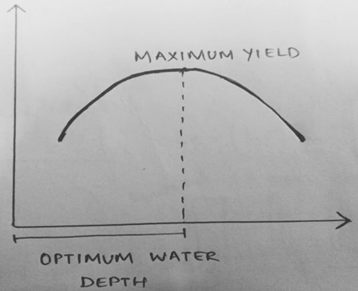This set of Irrigation Engineering online quiz focuses on “Optimum Utilisation of Irrigation Water”.
1. Which of the following statement is wrong?
a) The O.M.C is the water content at which the yield is maximum
b) Below O.M.C, the yield increases with water content to a certain value
c) After O.M.C, the yield decreases with the water content
d) After O.M.C, the yield increases with the water content
View Answer
Explanation: OMC is the moisture content at which the yield of the crop is maximum. Below OMC, sufficient water is not available so, the yield of the crop is less. After OMC, the sufficient amount of air is not available so, the productivity decreases.
2. The optimum utilisation of irrigation water means _________
a) Getting maximum yield with the maximum amount of water available
b) Getting maximum yield with any amount of water
c) Getting less yield with maximum water content
d) Getting less yield with the least water content
View Answer
Explanation: It generally means getting maximum yield with any amount of water. The water to be supplied should be such that so as to get optimum benefit ratio. It is done not only for the efficient use of water and maximum yield but, also to prevent waterlogging.
3. The productivity of crop increases with water reaches a maximum value then, falls down.
a) True
b) False
View Answer
Explanation: The yield increases with water, reaches a certain maximum value and then, falls down. The quantity of water at this maximum value is called optimum water depth.
4. Which factor doesn’t influence the root zone depth?
a) Type of soil
b) Type of crops grown
c) Sub-soil formation
d) The yield of the crop
View Answer
Explanation: Root zone depth is the maximum distance below the surface of the soil from which a particular crop derives water for use and develops its root system. It usually depends on soil type, subsoil formation, kinds of crop grown, the distance of water table from the ground surface, and amount of water supplied during irrigation.
5. For clayey soils, the depth of root-zone is less.
a) True
b) False
View Answer
Explanation: Clayey soils do not permit crop roots to penetrate to considerable depths. Hence, for clayey soils, the depth of root-zone is less.
6. The graph below shows the variation of _________

a) Yield v/s Water depth
b) Yield v/s Field capacity
c) Water depth v/s Yield
d) Yield v/s Optimum water depth
View Answer
Explanation: If a crop is sown using the different amount of water depths under identical conditions, the yield of the crop varies. The figure shows that the yield increases with an increase in water to a certain value then, decreases.
Sanfoundry Global Education & Learning Series – Irrigation Engineering.
To practice all areas of Irrigation Engineering for online Quizzes, here is complete set of 1000+ Multiple Choice Questions and Answers.
If you find a mistake in question / option / answer, kindly take a screenshot and email to [email protected]
- Practice Agricultural Engineering MCQs
- Check Agricultural Engineering Books
- Check Irrigation Engineering Books
- Check Civil Engineering Books
- Apply for Civil Engineering Internship
